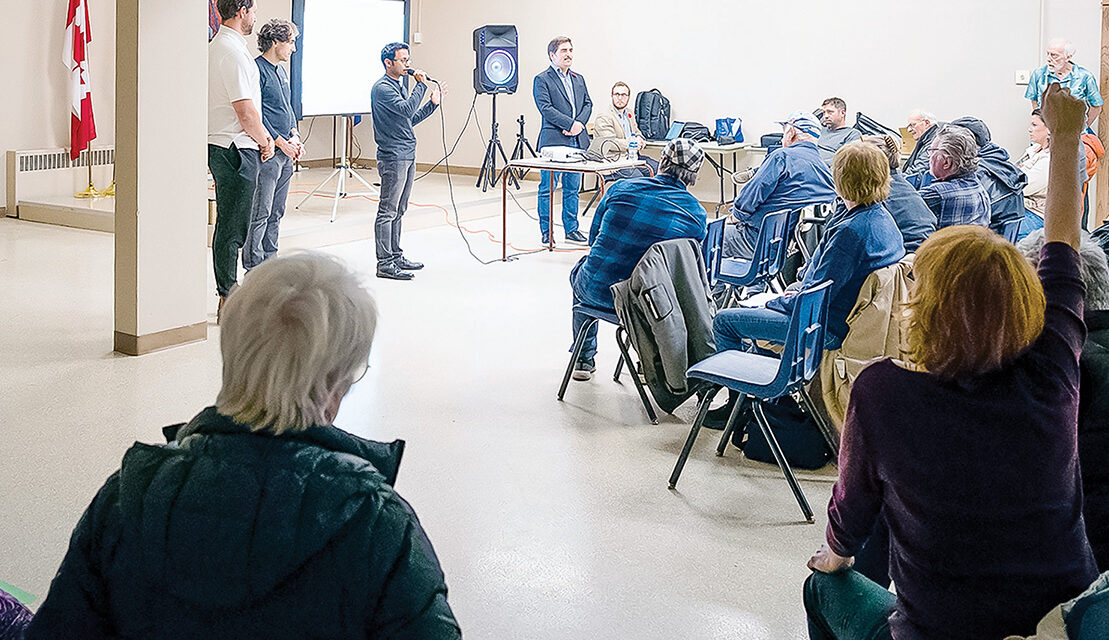There was a large, vocal crowd in attendance at the Morewood community centre for a presentation on the lithium battery storage facility being proposed for Marionville. The majority of those in attendance seemed to want to learn about what was being proposed and obtain answers that would eliminate their concerns. A few arrived with their mind made up and had little interest in the information being provided. Tinkess Photo
MARIONVILLE – Approximately 150 people spent their Friday night gathered at the Morewood Community Centre for the public open house information session on the proposed Marionville Energy Storage project (marionvilleenergystorage.com.)
Marionville Energy Storage LP, along with Baseload Power LP are the proponents of the project, a lithium-ion battery energy storage system that will be connected to Hydro One’s existing transmission system. The project is proposed to have a capacity of 75 megawatts and will consist of battery storage enclosures, inverters, medium voltage transformers, gravel access roads, electrical collector and communication cabling and a transmission transformer substation.
This, and similar projects across Ontario are being proposed because after a long period of strong electrical supply the Independent Electricity System Operator (IESO) is projecting a period of significant electricity need due to economic and population growth, manufacturing electrification and the retirement of the Pickering Nuclear generating facility. It is anticipated that 4,000 megawatts of additional capacity will be required.
The topic for the event was energy, and there was a surplus of it generated by those in attendance. In terms of opinion, it was a very diverse group. The majority were there to find out what the project was all about. They had genuine concerns, for which they wanted answers, but they attended to listen, ask questions, and hopefully leave with a better grasp of the project than when they arrived. Others had strong opinions, developed from information from a variety of sources, but were still prepared to listen with an open mind.
A smaller group arrived with their minds made up and didn’t seem interested in listening to the responses to their questions, if the responses didn’t match up with their preconceived notions. That was unfortunate as some of the points they brought up were certainly valid.
One thing that became obvious early in the meeting was the community’s misunderstanding of what the purpose of the energy storage facility is. Many thought that it would serve as an emergency power backup system, which is not accurate.
The purpose of this project and most if not all the others being proposed across the province is to store surplus electricity that is generated at times of low usage by existing infrastructure, so that it can be used at times of higher usage, in an effort to meet the projected requirements indicated above. Currently, surplus electricity, that which cannot be redistributed and used across Ontario’s portion of the grid, is exported to neighbouring provinces and states at prices that are lower than the cost of production, and on occasion these other users are paid to accept it.
The other misconception seemed to be that these storage facilities were a “done deal” and that the public hearings came too late to have any effect. At this point in time, the public open houses are being held by the proponents, which will be bidding for the opportunity to begin the process of meeting all the permit and approval requirements necessary for a project of this scale. As well, one of the requirements contained in the bid package refers to evidence of municipal support, evidence of Indigenous community participation, and evidence of Indigenous support. (All procurement documents can be found through a link on the company’s website (under provincial needs) as well as at https://www.ieso.ca/en/Sector-Participants/Resource-Acquisition-and-Contracts/Long-Term-RFP-and-Expedited-Process.)
The proponent must be selected as a winning bidder to pursue the project. If the proponent cannot obtain all permit and approval requirements, it cannot complete the project. The tender process only allows the winning bidder the opportunity to continue the process and is in no way a guarantee of success.
There were many concerns voiced, but a few came up repeatedly such as the possibility of fire, what would be the effect on the environment, why projects always seem to be built on prime agricultural land, what would the effect of noise be, and what happens at the end of the contract.
These questions won’t simply go away either. One of the requirements placed on the proponents who wish to submit a bid is that they hold a public meeting and that they publish a full report and post it on their website (marionvilleenergystorage.com) listing the information provided, the number of people who attended, and a summary of feedback received, and questions asked as well as any other applicable information. The Record will publish a follow-up article once that report is posted.
One person who attended a similar meeting in South Dundas on Monday as well as the meeting in Morewood stated that she wasn’t for or against the projects at the present time but felt that people needed to be informed so that they could make informed decisions. It is good to see that so many chose to take the opportunity to do so.
The deadline for the submission of bids is Dec. 12 at 3:00 p.m.

Terry Tinkess is a professional photographer, educator and journalist. He has been making a living with a camera and keyboard since 1999 and has been featured in such publications as The Ottawa Citizen, Cornwall Standard Freeholder, The Globe and Mail, The Miami Herald, Ottawa Construction News, The Ontario Construction Report, Ontario Home Builder Magazine, Reed Construction Data, Canadian Potato Business and most recently, The Record and Eastern Ontario AgriNews. Terry lives in Ingleside, Ontario with his wife Brenda, Mia the anxious Pittie and cats Wally and Chubbers.











